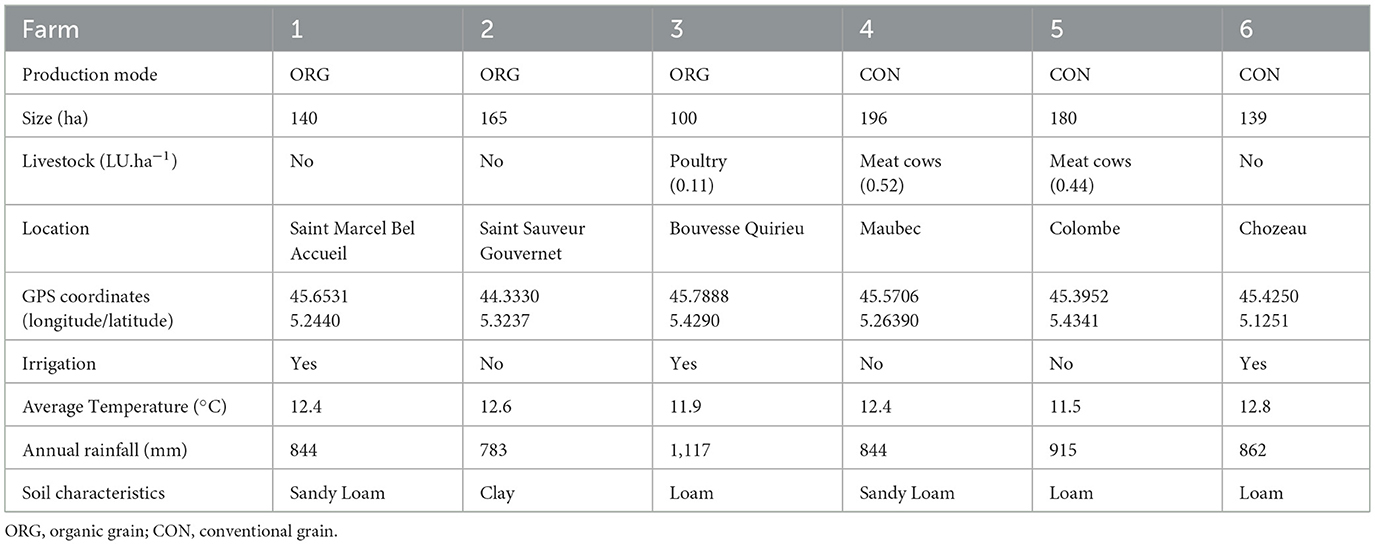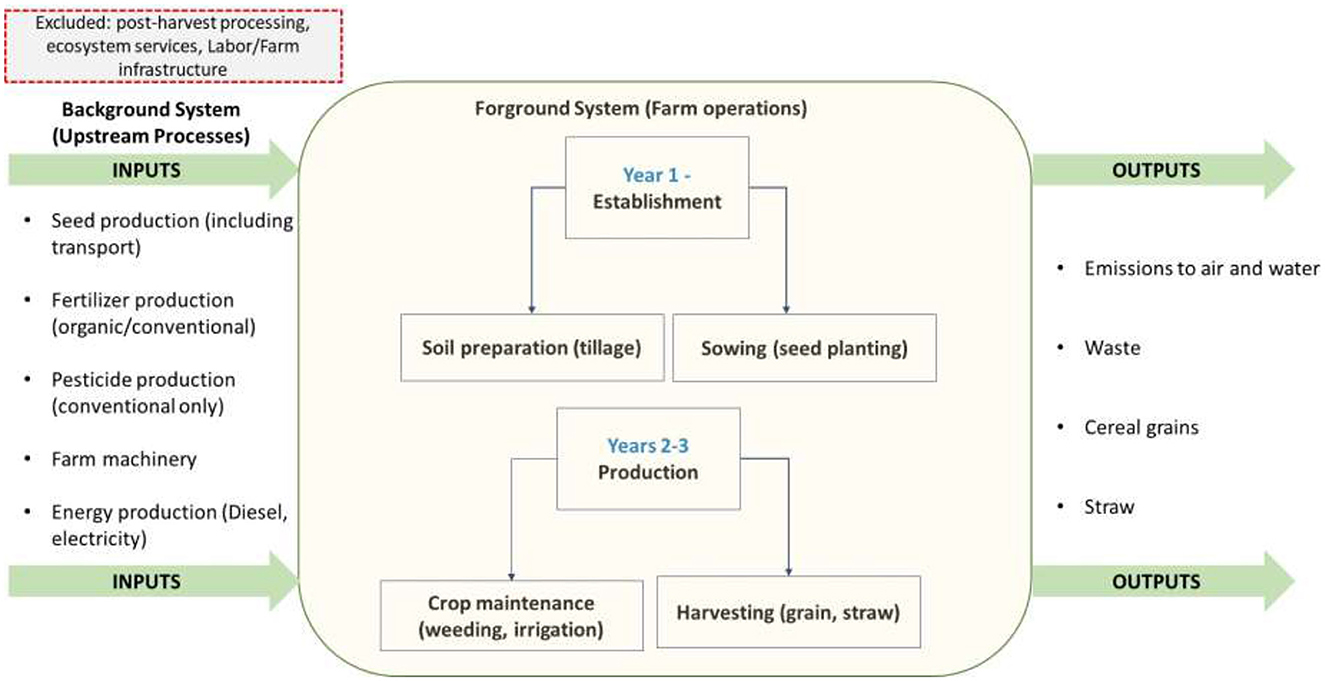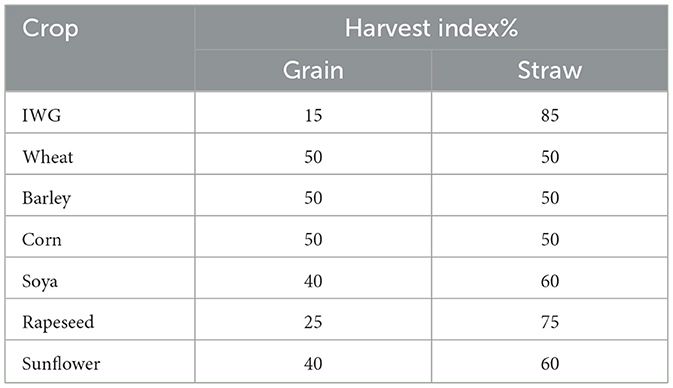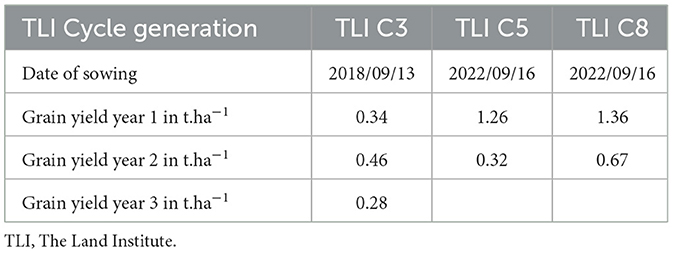- 1ISARA, AGRIVIA, Agroecology and Environment Unit, Lyon, France
- 2Lund University Centre for Sustainability Studies (LUCSUS), Lund, Sweden
- 3Department of Agricultural and Biosystems Engineering, Iowa State University, Ames, IA, United States
- 4Université Claude Bernard Lyon 1, CNRS, LAGEPP UMR 5007, Villeurbanne, France
The Intermediate Wheatgrass (IWG) Thinopyrum intermedium (Host) Barkworth & D.R. Dewey, marketed under the trade name Kernza® has been tested in France with a group of farmers since 2017. The Life Cycle Assessment (LCA) is a recognized methodology to assess the potential environmental impacts and resources consumption associated with a production system. An attributional LCA following ISO 14040/44 was conducted, focusing on static comparisons. The main purpose of this paper was to estimate the “cradle-to-farm gate” environmental effects caused by the cultivation of intermediate wheatgrassin comparison with the main crops produced, among which soft wheat and maize grain stand out. This research has been achieved with 6 farmers, 3 under organic and 3 under conventional production. A comparative assessment was carried out per year and under 3 years of crop rotation to determine contributions to the environmental impact. Several impact categories were evaluated, including global warming potential (GWP), ozone depletion (OD), freshwater eutrophication (FE) freshwater ecotoxicity (FEC) and acidification (AC). Intermediate wheatgrass (IWG) shows significantly better environmental performance per hectare than annual crops due to its perennial nature with limited soil preparation and lower input requirements. Conversely, IWG performs worse per ton due to its relatively low grain yield. IWG results shows higher contribution of mechanical practices than cash crops with 70% for GWP and OD and 20% with FE, AC and FEC due to low use of fertilizers and pesticides over the 3yr. Grain yields of organically grown crops are lower than those of conventionally grown crops, regardless of the crop. Conventional management shows higher environmental impacts than organic per hectare on IWG but also on annual crops in each category. Conversely organic management on IWG conduct to higher GWP and FE per volume due to regular mechanic weeding, inducing fuel consumption, and organic manure applied before sowing. The results on IWG show significant difference on environmental performance per hectare and per ton between establishment year inducing soil preparation, sowing and fertilization and succeeding years with limited practices except weed management and/or mulching.
1 Introduction
United Nations, Department of Economic and Social Affairs, Population Division (2019) shows that the world's population is expected to exceed 9 billion by 2050, leading to an expected +47% increase in food demand. Annual grains are an essential part of the human diet, accounting for 80% of global calories and 70% of global cropland (Pimentel et al., 2012; Crain et al., 2020). The intensification of production systems, leading to crop specialization and the systematic use of synthetic chemicals (nutrients, pesticides) and irrigation, can lead to a gradual degradation of soil and water quality, an increase in greenhouse gas (GHG) emissions, and a depletion of natural biodiversity and water availability (Crews et al., 2018; Tilman et al., 2002). Intensive tillage practices are also associated with the release of carbon dioxide into the atmosphere and soil erosion. A major challenge for the future of agriculture is to produce sufficient amounts of food with minimal environmental impact and reduced emissions. Promoting agroecology (e.g., organic farming, ecological intensification) guide future developments toward more sustainable farming systems to provide food while enhancing ecosystem services and reducing inputs.
Perennial grain crops can be part of the solution to the dual challenge of promoting food security while protecting environmental resources and resilience to climate change (Batello et al., 2013). The inclusion of perennial grain as intermediate wheatgrass (Thinopyrum intermedium, IWG) is a potential agroecological solution within current agricultural production systems (DeHaan et al., 2023). IWG could provide grain for human consumption and fodder for animals. This crop can also contribute to ecosystem services such as reduced erosion and nutrient leaching, increased carbon sequestration and reduced GHG emissions due to limited use of synthetic chemicals (de Oliveira et al., 2018, 2020; Sprunger et al., 2019; Woeltjen et al., 2024). The improved water retention through root density makes the plant more resilient to climate change and drought risks (Clément et al., 2022).
Efforts to domesticate IWG as a perennial grain crop accelerated in the early 2000′s. However, this crop currently has a low grain yield potential, reaching a maximum of 10%−20% of the potential of better modern wheat lines under a wide range of soil and climatic conditions (Larkin et al., 2014). Consequently, the lower yield per unit of land implies a greater need for arable land. The development opportunities for perennial grain need to be assessed in comparison with the major agricultural crops in Europe.
While the human health impacts of cereals have been extensively studied (e.g., gluten-related disorders), there is a growing global interest in understanding the environmental impacts of the producing and processing of grain products as a result. In addition, there is a growing need to understand the full life cycle impacts of products, particularly in terms of GHG emissions. As this applies to, for example, to scope 3 emissions reporting, suppliers and ingredient manufacturers increasingly need this data for customers downstream of them in the supply chain. The sustainability of agricultural production systems therefore needs to be assessed in order to predict the environmental impacts associated with production processes and product performance (in volume and per area). Despite some publications on the impact of perennial grain on ecosystem services and biodiversity (Crews and Rumsey, 2017; Rasche et al., 2017; Ryan et al., 2018), there is little research and published information on the environmental impacts of IWG compared to other grain production (e.g., Förster et al., 2023; Jungers et al., 2019; Sprunger et al., 2019). This leaves a gap in the assessment of IWG production and potential uses.
Life cycle assessment (LCA) is recognized as a powerful tool for quantifying and analyzing the potential environmental impacts of crop production by accounting for and assessing resource consumption and emissions (Meier et al., 2015). This is a commonly a useful method to identify and assess the potential environmental impacts of a product or service throughout its entire life cycle (Guinée et al., 2002; Klöpffer and Grahl, 2014).
Agricultural production systems are highly variable due to their dependence on agricultural practices (e.g., crop rotation, crop management) and farm site features such as soil type, water and nutrient availability, and climate (Fedele et al., 2014). The site-specific and climatic conditions can have a significant impact on crop performance, but also on LCA results. Furthermore, production systems are very diverse due to the numerous management decisions and the variety of agricultural practices (Fedele et al., 2014; Nemecek et al., 2012).
This study estimates the cradle-to-farm gate environmental impacts of IWG vs. annual crops in southeast France (wheat, corn, rapeseed, soya). Our analysis specifically examines: (i) how IWG's perennial growth habit influences environmental impacts relative to annual crop rotations, (ii) the effects of organic vs. conventional management practices, and (iii) year-to-year variability in environmental performance. By identifying key impact hotspots and improvement opportunities, this work provides critical insights for farmers and policymakers considering the integration of perennial grains into European agricultural systems.
2 Materials and methods
2.1 Experimental sites and cropping system description
The study was conducted to assess the impact of intermediate wheatgrass (IWG) compared to annual cash crops under conventional and organic farming systems in south-eastern France (Figure 1). The climatic and soil conditions in this region are favorable for grain and fodder production. The climate is a transition between the Central European and Mediterranean climates, with an average annual temperature of 12°C. Rainfall is mainly concentrated in autumn and spring, while there is a regular lack of water in summer, which may be compensated by irrigation. The average annual rainfall in the area is variable, depending on the location and the year, and ranges from 780 to 1,150 mm. The topsoil texture for arable crops ranged from sandy loam (with irrigation) to clay soils (Table 1). The climatic and soil conditions could affect the crop performance per year or per site.
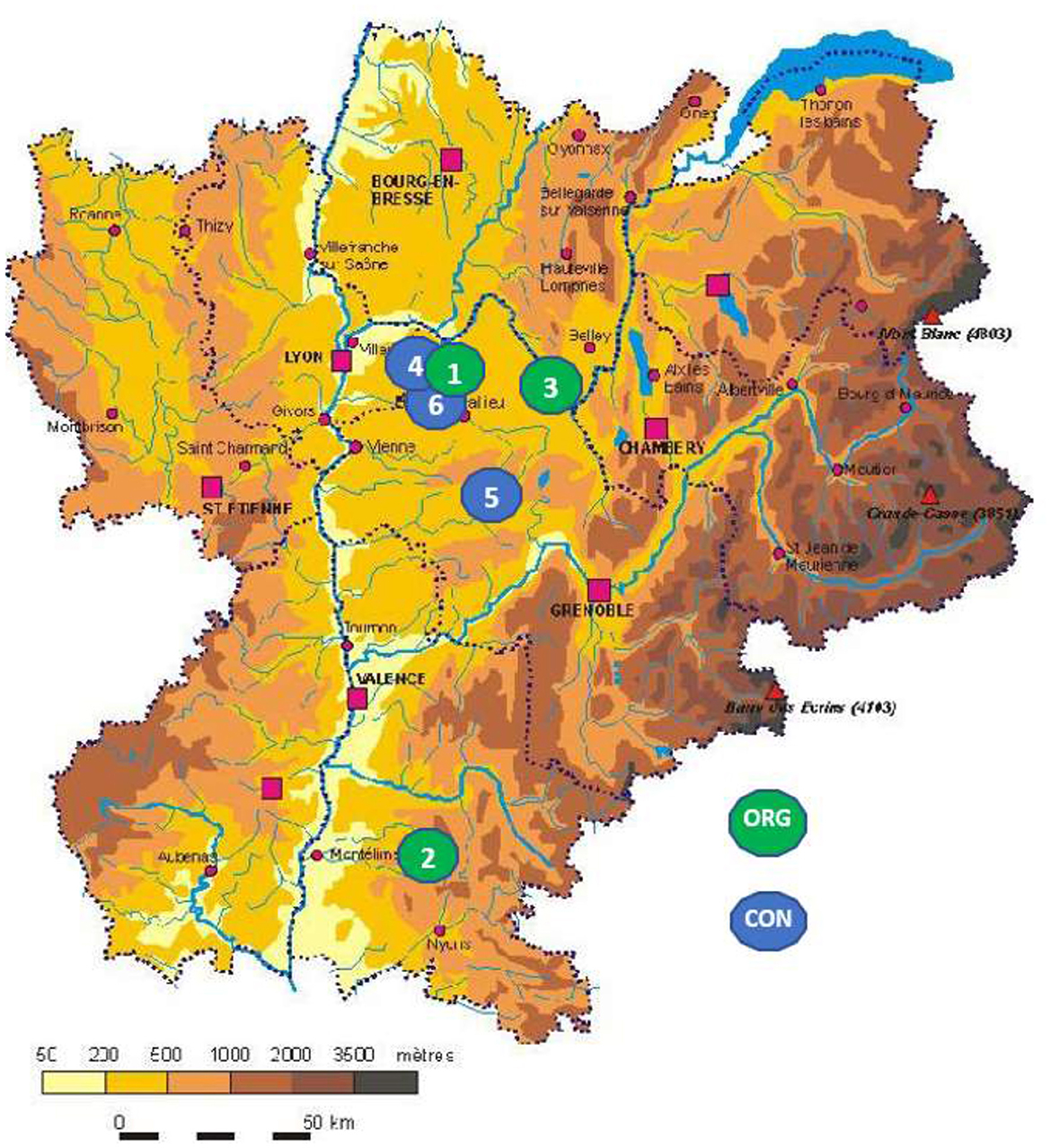
Figure 1. Representation of the study area in South East of France (Rhone Alpes region). ORG is organic grain. CON is conventional grain.
The selection of farmers is more representative of the agricultural diversity and performance in terms of grain production and farming systems of the south-east of France. Consequently, this research was carried out on 6 farms, 3 organic (farms 1, 2 and 3) and 3 conventional (farms 4, 5 and 6). The sample includes 3 livestock farms (farm 3 with organic poultry, farms 4 and 5 with conventional beef cattle) and 3 arable farms (farms 1 and 2 in organic and farm 6 in conventional) (Table 1). These farms have been testing IWG for 3 years in comparison with conventional annual crop rotation (Table 2). The grain yields were quite different between annual crops (Table 2) and IWG (Table 3).
A large majority of farmers (Farms 1, 3, 4, 5, and 6) considered IWG for grain production. However, Farm 2 produced IWG for forage crop (Table 3). A comparison of two reference fields (IWG vs. annual crop sequence) allowed us to obtain data per year and over 3 years. Individual data on agricultural practices were obtained from interviews with farmers and registered data from the CERPET research program.
The analysis was performed using data collected over a 3-year period, spanning the 2018–19 to 2021–22 growing seasons.
The observed data from the six farms showed differences in the crop rotation, inputs and crop management. In particular, the most relevant differences were observed between organic and conventional farms. For example, organic fertilization and mechanical weeding were used by organic farms (ORG), whereas conventional farms (CON) regularly used mineral fertilizers and synthetic herbicides and fungicides. The cultivation and yield performance were determined by (i) the type of crop and crop management and (ii) agricultural practices, with a high diversity of cash crops and more homogeneity in IWG.
2.2 Life cycle assessment
2.2.1 Goal and scope definition
An attributional LCA from cradle to farm gate following ISO 14040/44 was conducted, focusing on static comparisons. The main objective of this study was to assess and compare the environmental impacts of IWG cultivation over a 3-year period with a conventional crop rotation with cereal for human consumption (e.g., wheat, barley) and animal feed (corn, rapeseed, soya, and sunflower). As the crops under consideration are complementary, a comparative assessment was carried out to determine which of them would have the highest and which the lowest contribution to environmental impact. The analysis encompasses all processes from resource extraction (“cradle”) through farm gate, including:
• Agricultural inputs (fertilizers, pesticides, seeds).
• Field operations (tillage, planting, harvest).
• Direct field emissions.
• Machinery use and fuel consumption.
Impact assessment procedures, including aggregation, normalization and weighting have been implemented using Simapro software v7.3 by Pré Consultants for the “land use” and “resource consumption” dimensions. This approach ensures a holistic and interpretable analysis of complex impact categories that are particularly important in agricultural LCAs. Simapro is a widely recognized LCA software used in both academic and industrial settings, compliant with ISO 14040/44 standards. Its build-in methods allow for transparent, standardized and reproducible processing. In the context of comparing perennial (intermediate wheatgrass) and annual cropping systems, land use and resource consumption are particularly sensitive and policy-relevant dimensions.
The assessment employs two functional units (FU):
1. Mass-based Functional unit: One ton of dry grain (primary unit for product-level comparison).
2. Area-based Functional unit: One hectare of cropland (secondary unit for land-use efficiency evaluation).
These functional units are widely accepted in LCA of cropping systems. This dual approach is used to provide a comprehensive and balanced environmental evaluation of the crop production systems, as recommended in the LCA of agricultural products (ISO 14040, 2006; Nemecek et al., 2011). The mass-based FU expresses environmental impacts relative to the amount of product delivered, which is essential when the primary function of the system is to provide food or biomass. It allows for comparison of efficiency between systems in term of resource use and emissions per unit of outputs. The area-based FU reflects the land based environmental burden to understand land-use efficiency and ecosystems impacts on a per-area basis. This FU is important for assessing soil health, biodiversity and landscape-level impacts which are especially significant when considering long-term perennial systems.
Five environmental impact categories were selected in this study based on their established relevance to agricultural LCAs (Meier et al., 2015; Nemecek et al., 2012), and their endorsement in recognized LCA guidelines and methodologies as International Life Cycle Data System used in Europe. Global Warming Potential (GWP in kg CO2 eq) is a core impact category to estimate greenhouse gas emissions from agricultural practices; Ozone Depletion (OD in kg CGC-11* eq) may arise indirectly through the supply chains of agricultural inputs, OD is a baseline category to capture broader atmospheric impacts for system comparisons; Freshwater Eutrophication (FE in kg PO4 eq) is relevant for agriculture due to nutrient runoff, which leads to eutrophication in freshwater bodies, FE is crucial in comparing perennial vs. annual systems, as root systems and nutrient retention can differ significantly; Terrestrial Acidification (AC in SO2 eq) is primarily associated with ammonia and nitrogen oxide emissions from fertilizer use, acidification impacts are key for understanding soil and ecosystem health in agricultural contexts; and Freshwater Ecotoxicity (FEC in g 1,4-DB eq) reflects the toxic effects of pesticides or other chemicals on freshwater ecosystems. Since chemical use varies greatly between organic and conventional and perennial vs. annual systems, FE provides critical insight into ecological consequences.
These five impact categories are suitable for agricultural LCAs comparing perennial vs. annual crops under organic and conventional management. The two functional units allow different crops (IWG vs. annual cash crops) or farming system (e.g., organic vs. conventional) to be ranked according to their overall environmental performance.
The system boundary follows a cradle-to-farm gate approach, starting with soil preparation and terminating at the point of harvested grain. Post-harvest processing, distribution, and consumption phases were excluded, as the focus was on agricultural production impacts. A detailed flowchart of these system boundaries is provided in Figure 2. This study employs distinct foreground and background system boundaries to ensure transparent accounting of all life cycle inputs and emissions. Primary foreground data related to all on-farm operations (tillage, planting, fertilization, pest control, irrigation, harvesting grain and straw, direct fuel and energy consumption during field operations, farm-specific input application rates and timing, crop yield measurements) were collected through detailed farm surveys and field monitoring across all six study sites in southeastern France (three organic, three conventional, 2018–2022 growing seasons). LCA inventory is described in the Figure 2. The secondary background data (production and transportation of all agricultural inputs e.g., fertilizers, pesticides, seeds; manufacturing and maintenance of farm machinery; energy production and distribution) were obtained from the Agribalyse 3.1.1 database for regionally-specific agricultural inputs and the Ecoinvent database for other processes. The primary distinctions between organic and conventional management systems lie in pest control strategies (from 1 to 4 operations per crop) and nutrient inputs, with organic systems relying on non-synthetic approaches, whereas conventional systems utilize synthetic pesticides and fertilizers. It is important to note that the termination method in this study was limited to soil tillage, regardless of management system except for farmer 4 before seed rape with Glyphosate application. As a result, potential differences in emissions associated with chemical vs. mechanical practices were assessed on each farm and crop sequence.
In this study, environmental burdens were allocated using a partitioned approach based on the harvest index (Table 4), which divides impacts between grain (15%) and straw (85%) for IWG for example, following standard agricultural LCA practice. While the harvest index (HI) is indeed a mass-based ratio representing the proportion of grain relative to total above-ground biomass, we used it as a proxy to estimate the relative proportions of grain and straw for each crop, which were then allocated based on their respective economic values. In other words, the HI was used to estimate the quantities of co-products, while the final allocation was carried out using economic values in accordance with ISO 14044 recommendations. However, we acknowledge two important limitations regarding IWG's multifunctionality: (i) the current analysis does not account for IWG's additional ecosystem services (e.g., erosion control, nutrient retention) due to quantification challenges, and (ii) the fodder potential of IWG straw was excluded from system expansion to maintain consistency with the treatment of annual crop residues. This conservative approach was adopted because: (i) the study focuses on grain production as the primary functional output, (ii) reliable allocation factors for ecosystem services in perennial systems are not yet established in LCA databases, and (iii) including these benefits would require consequential modeling beyond our attributional framework.
2.2.2 Life cycle inventory
The inventory analysis included all resources used and environmental emissions for each phase of crop cultivation phase, starting from field preparation to the harvest. The cultivation phase consists of three sub-phases: field preparation including sowing, crop growth including fertilization, herbicides, and/or fungicides application and harvest. The inventory data for direct agricultural inputs were obtained through questionnaires and data recording completed by the farmers. The farmer interviews require information per field operation on type of equipment used, time (hour.ha−1), energy inputs such as diesel, fertilizers, pesticide, water use within the cropping season. Information was collected over three consecutive cropping seasons on two reference fields per farmer, 3 years of IWG compared to a conventional crop rotation (Table 2).
Secondary data regarding on the production of the different agricultural inputs, such as mineral fertilizers and pesticides were taken from the Ecoinvent database of the SimaPro software and the Agribalyse 3.1.1 database (Ademe database, 2022).
Inputs and outputs related to cropping activity were divided into 4 different factors in order to investigate the specific contribution of each:
- Use of crop growth inputs including fertilizers and pesticides (UCG): This category considers the direct impact of fertilizer and pesticide use in the field. The application of fertilizers differed. Due to their organic source, N-based fertilizers applied in ORG can be assumed to be more stable than those applied in CON. In fact, the N fertilizers used in CON have a synthetic source with a faster degradation rate and a higher risk of environmental losses. The use of synthetic herbicides, fungicides and nematicides in CON has a direct impact on emissions, whereas biocontrol products were rarely used in ORG,
- Crop growth inputs Manufacturing (CGM): This factor takes into account the impacts generated by the production of fertilizers and pesticides,
- Mechanical Practices (MP): This factor included the use of machinery for soil preparation and sowing, crop growth (fertilization, plant protection, irrigation) and harvesting. For each mechanical operation, tractor type and power, time and fuel consumption were taken into account, Others including the production of seeds and potential use of irrigation.
2.3 Effect of yield improvement on environmental impact of IWG
A domestication program to improve the grain yield of IWG has been relaunched in the early 2000 at the Land Institute (DeHaan et al., 2018). Recently, the use of new breeding technologies as genome sequencing and selection have accelerated domestication program with grain improvement (Crain et al., 2020; DeHaan et al., 2020). Although the improvement in yields remained limited compared to those obtained with annual wheat, the increasing yield could affect the environmental impact of IWG per ton. A new experiment has been set up on September 2022 to compare previous results obtained with Cycle 3 with new generations Cycle 5, establish in 2014, and Cycle 8, establish in 2018 (Table 5). These generations were tested on two plots of Farm 1 during two successive years in 2023 and 2024. Soil and climatic conditions are quite similar than the previous experiment set up on September 2018 with TLI C3 (Table 1).
3 Results
The field data show a significant difference among cropping sequence, IWG vs. annual cash crops. For example, grain yield ranged from 0.15 T.ha−1 to 0.90 T.ha−1 with IWG, while annual crops ranged from 2.8 T.ha−1 (rapeseed) to 9.3 T.ha−1 (corn). The wide yield variability observed in IWG is also reflected in its yield components, with spike density ranging from 160 to 470 spikes per m2 and grain weight per plant (GWP) fluctuating between 6.1 and 7.7 g per 1,000 seeds. The yield performance of IWG declined progressively from the first to the third year, with no statistically significant differences observed between organic and conventional management systems.
3.1 Comparative analysis of crops in rotation
3.1.1 Global environmental analysis
Table 6 shows the environmental impacts per impact category of the different crops on the basis of two functional units (per hectare and per ton). Intermediate wheatgrass (IWG) has the best environmental performance per hectare with a significant difference with annual crops for GWP, OD, FE, AC and FEC categories. IWG achieves a similar result with Alfalfa per ha due to its perennial nature and lower input requirements.

Table 6. Impact category indicators of IWG vs. annual and perennial crops per functional units (average of 6 farms on 3 years).
In contrast, IWG performs worse per ton due to its relatively low grain yield with consequence for GWP, OD, FE and FEC categories. The differences between the crops with the best and the worst environmental profile were substantial depending on the category. Corn was the cereal crop with the worst environmental results per hectare in almost all the categories. These results were mainly due to the higher requirements of fertilizers and herbicides or mechanical weeding.
3.1.2 Environmental analysis per agricultural system
This section presents and discusses in detail the results obtained in relation to the environmental impacts associated with the different agricultural systems. The agricultural systems used per crop over the life cycle are grouped into 4 contributing factors. Use of Crop Growth (UCG) inputs represents the direct emissions to air coming from the application of fertilizers, organic or mineral, and pesticides to the soil and plant during the cultivation of the different crops. Crop growth inputs Manufacturing (CGM) considers the impacts generated by the manufacturing processes of fertilizers and pesticide. Mechanical Practices (MP) are directly related to the use of diesel and energy for agricultural operations, including soil preparation, sowing, crop growth (fertilization, plant protection, irrigation) and harvesting. Tractor type and power, as well as time and fuel consumption were considered for each mechanical operation. Others included all emissions derived from seed production and use of irrigation considered within the system boundaries.
Tables 7–9 report the relative contribution of technological processes in crop production to the impact category indicators. Table 10 shows the results on global warming potential, ozone depletion, freshwater eutrophication, terrestrial acidification, and freshwater ecotoxicity.
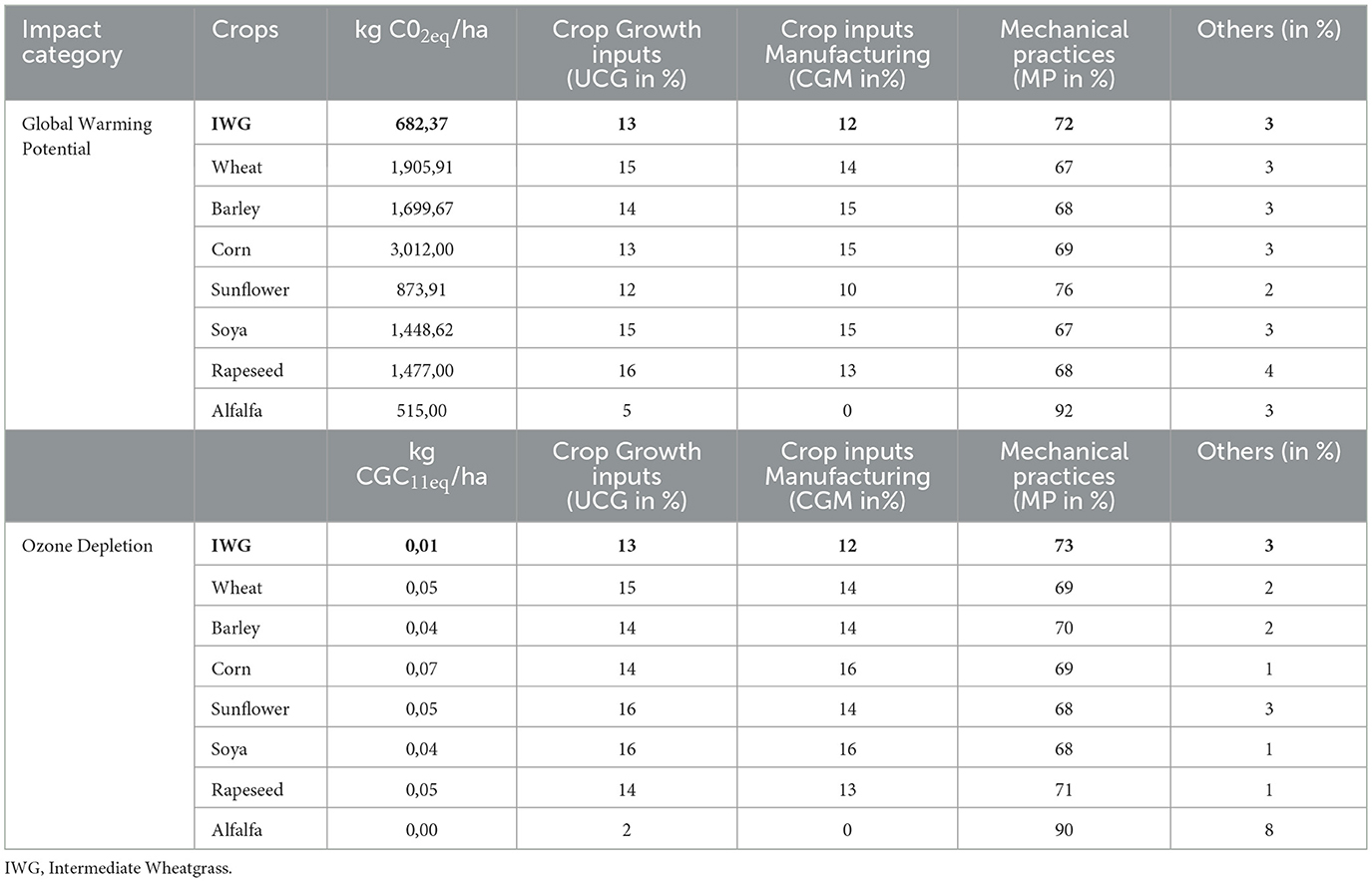
Table 7. Relative contribution of technological processes in crop production to the Global warming potential and ozone depletion (average for the 6 farms on 3 years).
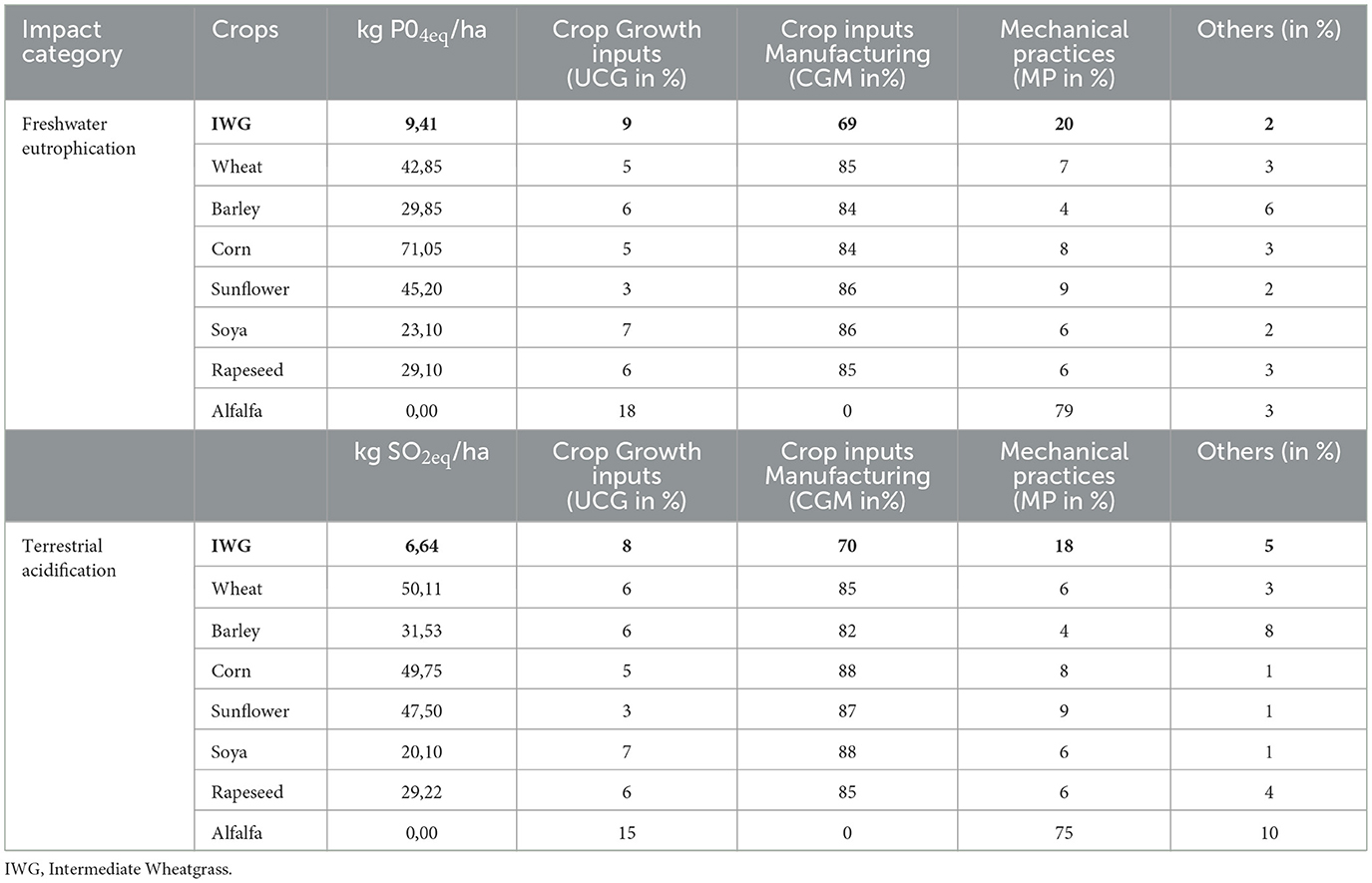
Table 8. Relative contribution of technological processes in crop production to the freshwater eutrophication and terrestrial acidification (average for the 6 farms on 3 years).
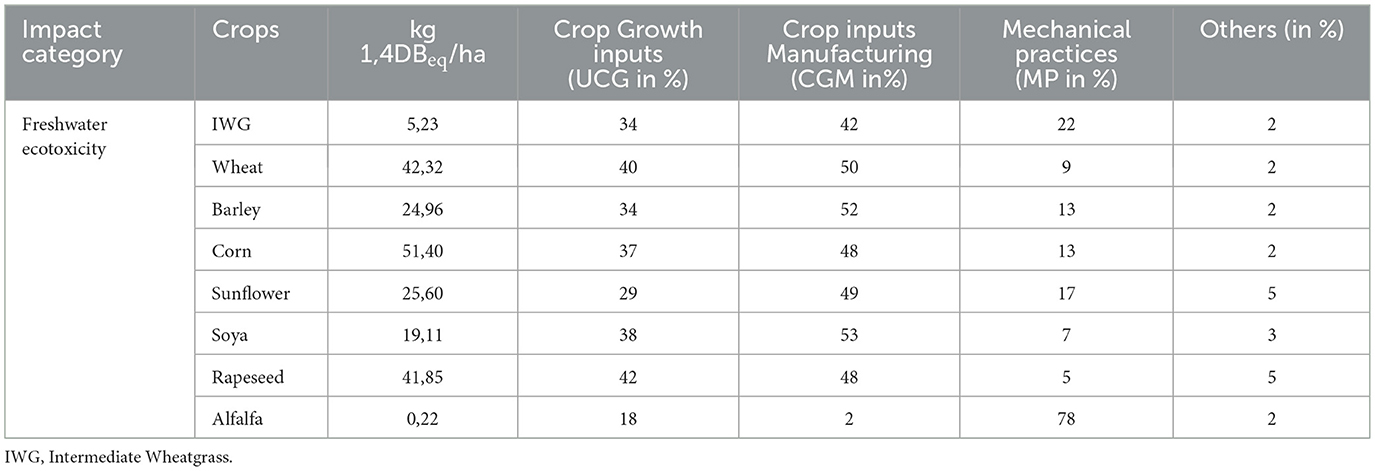
Table 9. Relative contribution of technological processes in crop production to freshwater ecotoxicity (average for the farms on 3 years).
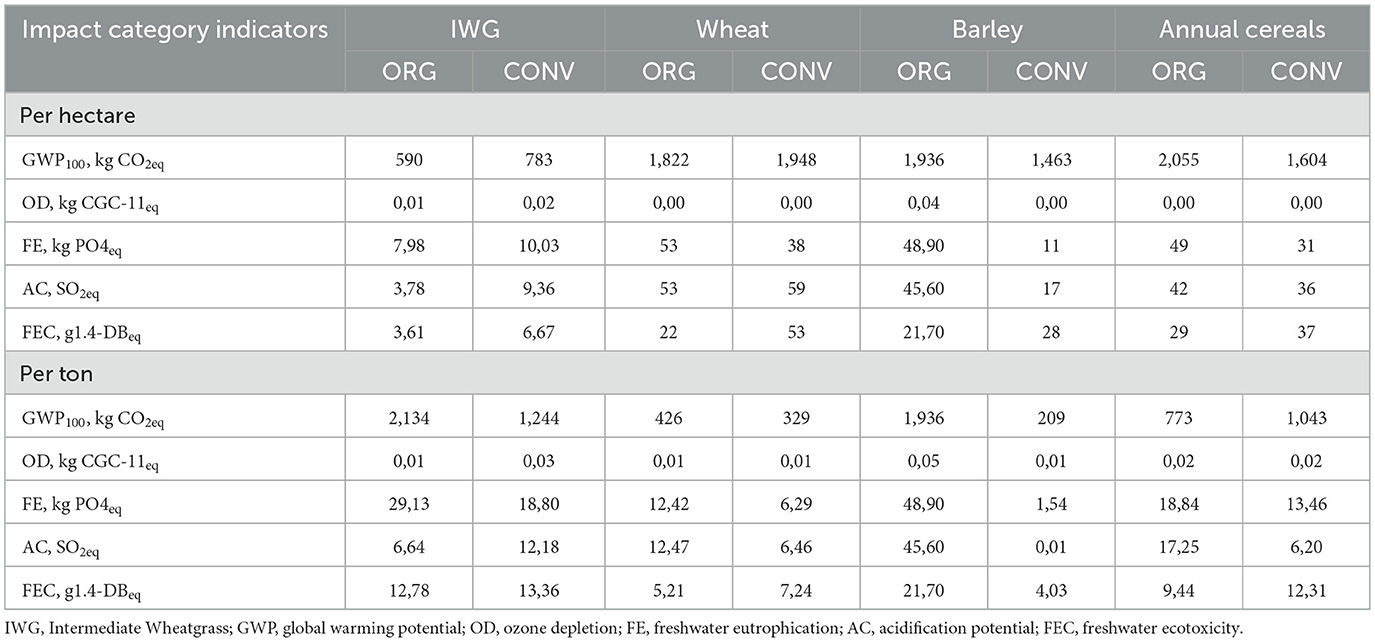
Table 10. Effect of crop management on Impact category indicators of IWG, Wheat, Barley, and All annual cereals per ha and per ton (average of 6 farms on 3 years).
Figure 3 shows the contributing factors over the life cycle of each crop on the global warming potential produced per hectare. The respective contribution (in %) of the different inputs (UGC, CGM, MP and others) are quite similar per ha and ton (data not shown). Mechanical practices in agriculture, including soil preparation, sowing, weed control and fertilization, with organic or conventional methods, have a strong impact on Global Warming Potential and Ozone Depletion (from 62% to 76%, Table 7). Field emissions, which include the impact of direct emissions to air coming from the application of fertilizers and herbicides, have a strong impact on freshwater eutrophication and acidification and a minor impact on freshwater ecotoxicity (from 69% for IWG to 88% for annual crops, Tables 8, 9). The environmental impact of pesticide and synthetic fertilizer manufacturing processes is limited (<15% for all crops), except for freshwater ecotoxicity (from 18% to 42% in Table 10). Others figures shown in Supplementary material 2 are the impact contributions for each crop (rate and value).
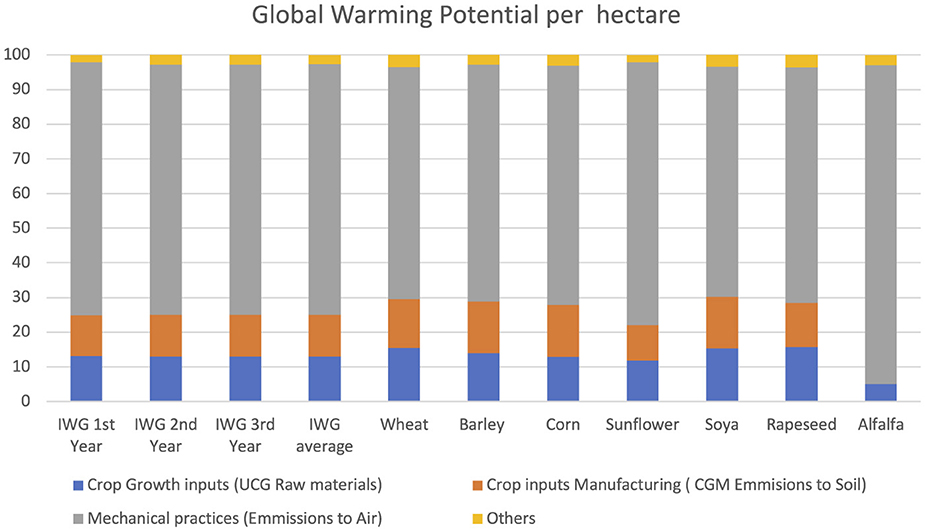
Figure 3. Impact contributions to Global Warming Potential for each crop (average of 6 farms over 3 years).
Finally, IWG had a significantly better environmental profile per ha due to limited soil preparation, only year 1, and low use of fertilizers and pesticides (Tables 6–9). Perennial crops like IWG and alfalfa had the lowest environmental impact per hectare due to their perennial nature. Conversely, corn, wheat and rapeseed have the worst environmental profile per hectare, especially in terms of global warming potential and field emissions affecting eutrophication and acidification.
IWG results show higher contribution of mechanical practices than cash crops with 70% for GWP and OD and 20% for FE, AC and FEC due to low fertilizers use over the 3 yr. The IWG values per hectare are significantly low compared to annual crops (see Section 3.1.1).
3.2 Comparative analysis of crop management
3.2.1 Global analysis on impact category indicators
Field data show a significant difference in grain yield between organic and conventional methods. For example, with IWG, organic grain yield ranged from 0.15 T.ha−1 to 0.67 T.ha−1 with a mean of 0.43 T.ha−1. Then, the conventional grain yield ranged from 0.13 T.ha−1 to 0.9 T.ha−1 with a mean of 0.58 T.ha−1. For annual crops, average grain yield for organic was 4.1 T.ha−1 and for conventional 5.2 T.ha−1, including different crops in the crop rotation. Corn and soya only in organic vs. rapeseed and sunflower in conventional.
Table 10 shows the effect of crop management (Organic vs. Conventional) on impact category indicators of IWG, Wheat, Barley and Annual Cereals per hectare and per ton. According to the results, conventional management shows higher environmental impacts than organic per hectare on IWG in each category due to the incidence of regular use of mineral fertilizer and pesticide. Conversely, organic management leads to higher GWP and FE with IWG per ton due to regular mechanical weeding which increases fuel consumption, and organic manure applied before sowing. These results are influenced by low grain yield.
The data show variable results between organic and conventional management for annual crops. The data for the different cereals tested (wheat, barley, sunflower, soya, corn and rapeseed) show large differences (Table 6). Only organic corn and soya have a negative impact on GWP. The regular use of pesticides and mineral fertilizers in conventional rapeseed, sunflower and wheat, could affect GWP and FE.
Conventional management shows higher environmental impacts than organic per ton on cereals in GWP and FEC, but with lower impacts in FE and AC—incidence of mineral fertilization and pesticides vs. organic fertilizer and mechanical weeding in GWP and FEC and higher use of P2O5 in organic crops.
3.2.2 Comparative analysis of IWG per year
Table 11 shows the effect of crop management (organic vs. conventional) on the impact category indicators of IWG per cropping season, years 1 to 3 per hectare and per ton.
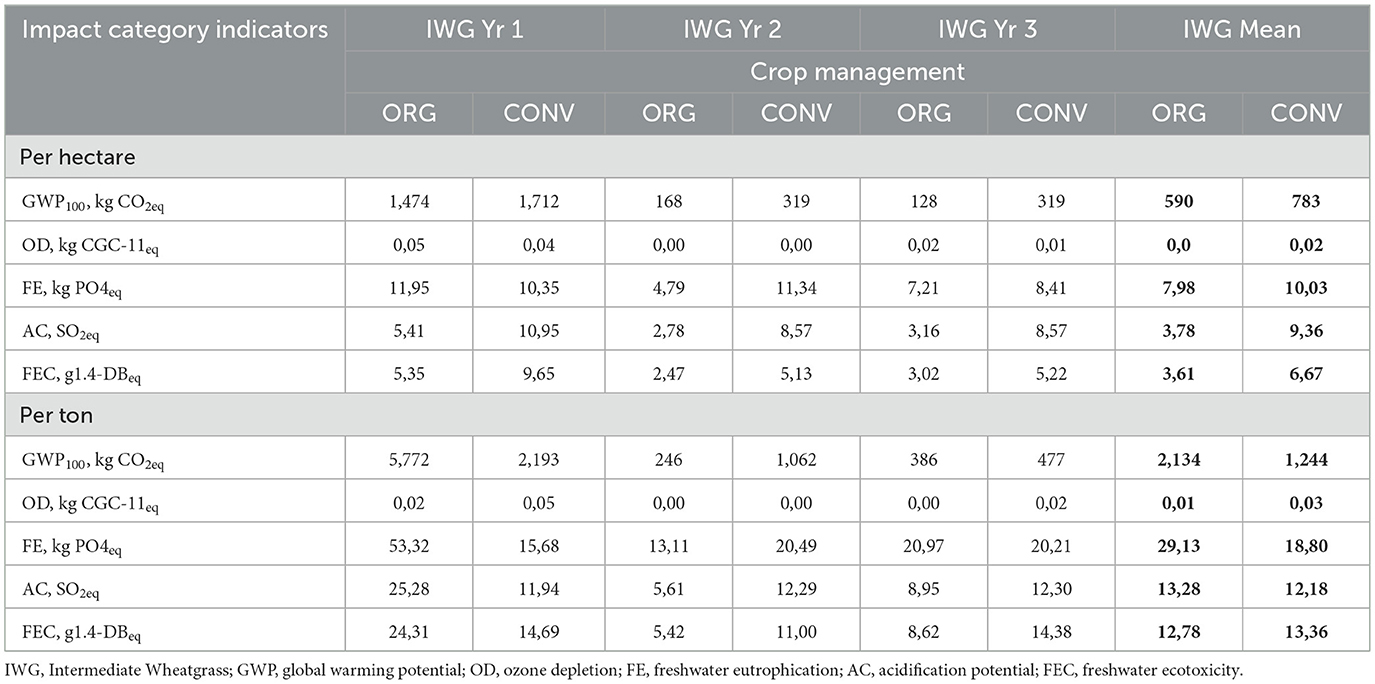
Table 11. Effect of crop management on Impact category indicators of three succeeding years of IWG per hectare and per ton (average of 6 farms on 3 succeeding years).
Intermediate wheatgrass (IWG) shows a slow reduction of grain yield with 0,53 T.ha−1 in year 1 and 0,56 T.ha−1 in year 2, and 0,41 T.ha−1 in year 3. The results show a significant difference on environmental performance per hectare and per ton between establishment year inducing soil preparation, sowing and fertilization and the following years with limited practices except for weed control and/or mulching.
According to the results, establishment year of IWG shows high environmental impacts per volume but also per hectare on GWP, FE, AC, and FEC with lower impacts in years 2 and 3. Organic management induces higher environmental impacts per volume in the establishment year when the organic yield is much lower (0,38 vs. 0,69 T.ha−1). Conversely, conventional management induces higher environmental impacts in years 2 and 3 even when organic grain yields are still (0,45 vs. 0,53 T.ha−1 based on the average of years 2 and 3).
3.3 Effect of yield improvement of TLI cycle generation of IWG on environmental impacts
Table 12 shows the incidence of yield improvement of three TLI generations on the impact category indicators of IWG per hectare and per ton compared to annual wheat (results obtained on Farm 1).

Table 12. Effect of TLI cycle generation of IWG on impact category indicators per hectare and ton (experiment on farm 1- data collected from 2018 to 2024).
The result shows a significant improvement in grain yield per cycle generation in the establishment year, but also with a slight difference in year 2. This grain improvement strongly limits the environmental impact per ton in all the categories from 63% to 75%. It is important to highlight that a limited grain improvement, reaching <20% of the annual grain yield−1.3 t.ha−1 for IWG vs. 6.2 t.ha−1 for wheat, has a remarkable effect on the environmental impact of IWG. The environmental impact of IWG Cycle 8 on ozone depletion, acidification and water ecotoxicity is quite similar to the results obtained with annual wheat. Conversely, the impact of IWG on global warming potential and eutrophication is still slightly higher than for annual crops.
4 Discussion
4.1 Impact of the functional units
This study employed two complementary functional units to evaluate environmental impacts from different perspectives: (1) 1 ton of grain (dry basis) to assess production efficiency, and (2) 1 hectare of cropland to evaluate land-use efficiency. The primary function of the studied systems is grain production for human consumption, with the ton-based unit serving as the principal reference for product-level comparisons. The hectare-based unit provides additional insight into spatial resource use efficiency, particularly relevant for assessing perennial systems like IWG that deliver ecosystem services beyond grain yield. While financial metrics could theoretically offer another dimension for comparison (Nemecek et al., 2011), they were intentionally excluded from this analysis because: (i) market prices for IWG grain remain unstable and regionally variable, (ii) the study focuses on biophysical rather than economic assessment, and (iii) economic valuation of ecosystem services would require additional methodological frameworks beyond standard LCA. The consistent patterns observed across both functional units (lower impacts per hectare but higher impacts per ton for IWG) strengthen the robustness of our conclusions, though we emphasize that the ton-based results are most directly comparable to conventional LCA studies of grain production systems.
4.2 Impact of the crop rotation
Crop rotation composition influences not only crop performance, but also N management, mechanization and pesticide use, which affect environmental performance. The environmental impact of crop rotations must be interpreted within the time frame of the study period (3 years in this study). While perennial IWG systems have distinct impacts during establishment (year 1) and production years (years 2–3), our analysis treats these as discrete phases rather than amortizing the impacts over a full perennial life (typically 5–7 years). This approach reflects conventional LCA practice for annual crop rotations, where the impacts of each year are considered independently. However, we recognize three critical temporal considerations that warrant discussion: (1) The high initial impacts of IWG establishment (soil preparation, seeding) would be proportionally lower if spread over its potential 5-year productive life (e.g., year 1 GWP of 1,474 kg CO2-eq/ha would be reduced to ~295 kg CO2-eq/ha/year over 5 years); (2) annual crop rotations also incur recurring establishment impacts each year that are not amortized in our analysis; and (3) the 3-year assessment window may not capture long-term benefits of perennials such as soil carbon accumulation. While dynamic LCA approaches may better account for these temporal effects, our attribution framework intentionally assessed comparable time periods (3-year rotation vs. 3-year IWG stand) to maintain methodological consistency. Future studies should consider (i) longer evaluation periods that capture the full perennial life cycle, and (ii) dynamic attribution methods that distribute impacts across multiple years of productivity.
4.3 Impact of the crop management
When using mass-based environmental performance, organically produced wheat and barley have higher environmental impacts than conventional ones in all categories. This better performance of conventional cereal is partly explained by yield differences (4.3 t.ha−1 in organic vs. 6.2 t.ha−1 in conventional). These results confirmed previous investigations by (Verdi et al. 2022) on ancient wheat varieties. Conventional farming showed the worst performance, primarily due to the production and consumption of non-renewable resources. However, the lower yields observed in organic systems negatively impacted the mass-based environmental performance, highlighting a trade-off between resource use efficiency and yield. This suggests that while organic practices may offer environmental benefits in terms of input sustainability, their lower productivity can offset these advantages when assessed per unit of product.
According IWG, these results are different for OD, AC, and FEC, where organic management give better environmental performance. The absence of pesticides and mineral fertilization in organic conditions with a slight difference between Organic IWG performance (0.43 t.ha−1) and Conventional IWG (0.58 t.ha−1) explains these results.
When using 1 hectare as a functional unit, organic IWG is more environmentally-friendly than conventional in all impact categories due to the limited use of mechanical practices and inputs. Results are more sensitive on annual cash crops with higher environmental impact with organic methods. These results are mainly explained by the use of manure and organic fertilizer, especially for wheat and corn in particular. In addition, regular mechanical weed control in spring crops (e.g., soya and corn) resulted in higher fuel consumption per hectare.
4.4 IWG has a low environmental impact per land occupation, hosting ecosystem services
According to the environmental results per land occupation, IWG has the best environmental profile, with the lowest burdens in all the impact categories. These results confirm the benefits of IWG in providing ecosystem services. Research has shown that IWG can significantly reduce soil nitrate leaching compared to annual cropping systems (Culman et al., 2013; Jungers et al., 2019). Continuous root presence improves carbon input and reduces losses. For instance, (Glover et al. 2010) showed that IWG has deeper and denser root systems than wheat, enhancing belowground carbon storage. (Sprunger et al. 2019) and (Culman et al. 2013) also reported greater below ground carbon storage in the root zone compared to annual grain systems. (Paustian et al. 2016) emphasize that minimizing tillage is one of the most effective practices to maintain or increase soil organic carbon (SOC). (Jungers et al. 2019) report that long-term IWG cultivation under reduced tillage maintains or enhances SOC, particularly in surface soils. Carbon stocks, soil and water conservation are key elements provided by IWG. Although carbon stocks were higher in the rooting zone of intermediate wheatgrass, the available data are insufficient to draw definitive conclusions about its long-term carbon sequestration potential.
Therefore, IWG has the potential to provide both food, for human consumption and animal feed, and ecosystem services throughout the crop cycles. However, its grain yield potential remains low compared to its annual counterparts, with a maximum of 1 t ha−1 (Fagnant et al., 2024), as its fodder production consists of mainly summer straw (Culman et al., 2023). The grain production needs to be improved to reduce the environmental impact per ton but above all to make it economically viable for farmers to adopt the crop. The results show that the sustainability of IWG is highly dependent on grain yield performance but also on how hay or straw co-product is used (Law et al., 2022).
4.5 Limitations and future research
While this study provides a comprehensive midpoint-level comparison of perennial and annual cropping systems, we recognize that including endpoint impact categories (e.g., human health effects, ecosystem quality) could offer additional insights into the broader sustainability implications of these farming systems. The exclusion of endpoint analysis was primarily due to (i) the study's focus on direct agricultural processes where midpoint indicators are most policy-relevant, and (ii) the significant additional uncertainty introduced when aggregating impacts to endpoint categories, particularly for agricultural systems where characterization factors for biodiversity and human toxicity remain under development. Future research should explore integrated midpoint-endpoint approaches to better capture trade-offs between, for instance, reduced pesticide use (midpoint) and its consequences for farmer health (endpoint). Such analyses would particularly benefit perennial systems where long-term soil health improvements may translate to meaningful endpoint-level advantages that are not fully captured by current midpoint indicators.
5 Conclusion
This study provides three key evidence-based conclusions from our cradle-to-farm gate LCA of intermediate wheatgrass (IWG) production: (1) IWG demonstrates significantly lower environmental impacts per hectare (GWP: 682 kg CO2-eq/ha vs. 1,477–3,012 kg CO2-eq/ha for annual crops) due to reduced soil disturbance and input requirements, though higher impacts per ton of grain (GWP: 1,798 kg CO2-eq/t vs. 316–495 kg CO2-eq/t) reflect current yield limitations; (2) organic management further reduces IWG's per-hectare impacts (GWP: 590 kg CO2-eq/ha) but exacerbates per-ton trade-offs (GWP: 2,134 kg CO2-eq/t) due to lower yields; and (3) new IWG cultivars (TLI C8) show potential to bridge this yield gap, reducing per-ton impacts by 63%−75% compared to earlier generations. These conclusions are strictly derived from our analysis of the five impact categories (GWP, OD, FE, AC, and FEC) actually assessed in this study. While the broader agroecological potential of perennial systems (e.g., carbon sequestration, soil health) is well-documented in the literature (Culman et al., 2013; Jungers et al., 2019), such ecosystem services were not quantified in our LCA framework and are therefore not claimed as findings. We recommend future work to: (i) incorporate emerging methodologies for quantifying perennial crops' ecosystem services in LCA, and (ii) extend the assessment period beyond 3 years to capture IWG's full productive lifespan. It is also essential to conduct a Life Cycle Assessment (LCA) of perennial grains, focusing on their environmental impacts, alongside a socio-economic analysis. This combined approach can help evaluate the potential of perennial grains to enhance food security, support economic growth, and contribute to social development (Vinci et al., 2022).
Future research should also focus on improving the grain yield of IWG through breeding programs. Efforts should be expanded to quantify ecosystem services, integrate IWG into diverse cropping and livestock systems, and evaluate economic viability. Holistic assessments must include post-harvest processing technologies, food product development and consumer behavior. Policy advocacy and stakeholder engagement are critical to promote adoption and scale up the use of IWG for a sustainable food system.
Data availability statement
The raw data supporting the conclusions of this article will be made available by the authors, without undue reservation.
Author contributions
CD: Conceptualization, Funding acquisition, Project administration, Supervision, Writing – review & editing. XA: Writing – original draft, Data curation, Formal analysis. KR: Writing – review & editing. SG: Formal analysis, Writing – review & editing.
Funding
The author(s) declare that financial support was received for the research and/or publication of this article. This research was performed within the frame of the collaborative project NAPERDIV, which was funded through the 2019–2020 BiodivERsA joint call for research proposals, under the BiodivClim ERA-Net COFUND program, and the national funding organization ANR N° ANR-20-EBI5-0007-04.
Acknowledgments
We would like to thank the farmers, but also Camille Bathellier, Christelle Ginot, and Cyrille Thomas for sustaining the intermediate wheatgrass network. Therefore, we thank Manuel Garcia, and Laurent Chippaux from Alma Pro and Albertomaria Franzoni and Alberto Cartasegna from Miscusi SA (Milano) for their support in the post-harvest treatment. Finally, we would like to express our gratitude for the seed material generously provided by Lee DeHaan and Tim Crews from the Land Institute.
Conflict of interest
The authors declare that the research was conducted in the absence of any commercial or financial relationships that could be construed as a potential conflict of interest.
Correction note
A correction has been made to this article. Details can be found at: 10.3389/fsufs.2025.1702892.
Generative AI statement
The author(s) declare that no Gen AI was used in the creation of this manuscript.
Publisher's note
All claims expressed in this article are solely those of the authors and do not necessarily represent those of their affiliated organizations, or those of the publisher, the editors and the reviewers. Any product that may be evaluated in this article, or claim that may be made by its manufacturer, is not guaranteed or endorsed by the publisher.
Supplementary material
The Supplementary Material for this article can be found online at: https://www.frontiersin.org/articles/10.3389/fsufs.2025.1569398/full#supplementary-material
References
Batello, C., Wade, L., Cox, S., Pogna, N., Bozzini, A., and Choptiany, J. (2013). “Perennial crops for food security,” in Proceedings of the FAO Expert Workshop (Rome).
Clément, C., Sleiderink, J., Svane, S. F., Smith, A. G., Diamantopoulos, E., Desbrøll, D. B., et al. (2022). Comparing the deep root growth and water uptake of intermediate wheatgrass (kernza®) to alfalfa. Plant Soil 472, 369–390. doi: 10.1007/s11104-021-05248-6
Crain, J., Bajgain, P., Anderson, J., Zhang, X., DeHaan, L., and Poland, J. (2020). Enhancing crop domestication through genomic selection, a case study of intermediate wheatgrass. Front. Plant Sci. 11:319. doi: 10.3389/fpls.2020.00319
Crews, T. E., Carton, W., and Olsson, L. (2018). Is the future of agriculture perennial? Imperatives and opportunities to reinvent agriculture by shifting from annual monocultures to perennial polycultures. Glob. Sustain. 1, 1–18. doi: 10.1017/sus.2018.11
Crews, T. E., and Rumsey, B. E. (2017). What agriculture can learn from native ecosystems in building soil organic matter: a review. Sustainability 9:578. doi: 10.3390/su9040578
Culman, S., Pinto, P., Pugliese, J., Crews, T., DeHaan, L., Jungers, J., et al. (2023). Forage harvest management impacts “kernza” intermediate wheatgrass productivity across north America. Agron. J. 115, 2424–2438. doi: 10.1002/agj2.21402
Culman, S., Snapp, S., Ollenburger, M., Basso, B., and DeHaan, L. (2013). Soil and water quality rapidly responds to the perennial grain kernza wheatgrass. Agron. J. 105, 735–744. doi: 10.2134/agronj2012.0273
de Oliveira, G., Brunsell, N. A., Crews, T. E., DeHaan, L. R., and Vico, G. (2020). Carbon and water relations in perennial kernza (Thinopyrum intermedium): an overview. Plant Sci. 295:110279. doi: 10.1016/j.plantsci.2019.110279
de Oliveira, G., Brunsell, N. A., Sutherlin, C. E., Crews, T. E., and DeHaan, L. R. (2018). Energy, water and carbon exchange over a perennial kernza wheatgrass crop. Agric. Forest Meteorol. 249, 120–137. doi: 10.1016/j.agrformet.2017.11.022
DeHaan, L., Christians, M., Crain, J., and Poland, J. (2018). Development and evolution of an intermediate wheatgrass domestication program. Sustain 10:1499 doi: 10.3390/su10051499
DeHaan, L., Crain, J., Poland, J., Sacks, E., Anderson, J., Bajgain, P., et al. (2023). Discussion: prioritize perennial grain development for sustainable food production and environmental benefits. Sci. Total Environ. 895:164975. doi: 10.1016/j.scitotenv.2023.164975
DeHaan, L., Larson, S., Lopes-Marqués, R. L., Wenkel, S., Gao, C., and Palmgren, M. (2020). Roadmap for accelerated domestication of an emerging perennial grain crop. Trends Plant Sci. 25, 525–537 doi: 10.1016/j.tplants.2020.02.004
Fagnant, L., Duchene, O., Celette, F., and Dumont, B. (2024). Maintaining grain yield of Th. intermedium across stand age through constant spike fertility and spike density: understanding its response to various agronomic managements. Eur. J. Agron. 152:127038. doi: 10.1016/j.eja.2023.127038
Fedele, A., Mazzi, A., Niero, M., Zuliani, F., and Scipioni, A. (2014). Can the Life Cycle Assessment methodology be adopted to support a single farm on its environmental impacts forecast evaluation between conventional and organic production? An Italian case study. J. Clean. Prod. 69, 49–59. doi: 10.1016/j.jclepro.2014.01.034
Förster, A., David, C., Dumont, B., Dimitrova Martensson, L. M., Rasche, F., and Emmerling, C. (2023). Earthworm populations and diversity under annual and perennial wheat in a North to South gradient in Western Europe. Eur. J. Soil Biol. 119:103561. doi: 10.1016/j.ejsobi.2023.103561
Glover, J. D., Reganold, J. P., Bell, L. W., Borevitz, J., Brummer, E. C., Buckler, E. S., et al. (2010). Agriculture: increased food and ecosystem security via perennial grains. Science 328, 1638–1639. doi: 10.1126/science.1188761
Guinée, J., Gorrée, M., Heijungs, R., Huppes, G., Kleijn, R., and de Koning, A. (2002). Handbook on life cycle assessment: operational guide to the ISO Standards. Series: Eco-efficiency in Industry and Science.
Jungers, J. M., DeHaan, L. H., Mulla, D. J., Sheaffer, C. C., and Wyse, D. L. (2019). Reduced nitrate leaching in a perennial grain crop compared to maize in the Upper Midwest, USA. Agric. Ecosyst. Environ. 272, 63–73. doi: 10.1016/j.agee.2018.11.007
Klöpffer, W., and Grahl, B. (2014). Life Cycle Assessment (LCA) : A Guide to Best Practice. Weinheim, Germany: Wiley-VCH, 440. doi: 10.1002/9783527655625
Larkin, P. J., Newell, M. T., Hayes, R. C., Aktar, J., Norton, M. R., Moroni, S. J., et al. (2014). Progress in developing perennial wheats for grain and grazing. Crop Pasture Sci. 65, 1147–1164. doi: 10.1071/CP13330
Law, E. P., Wayman, S., Pelzer, C. J., Culman, S. W., Gómez, M. I., DiTommaso, A., et al. (2022). Multi-criteria assessment of the economic and environmental sustainability characteristics of intermediate wheatgrass grown as a dual-purpose grain and forage crop. Sustainability 14:3548. doi: 10.3390/su14063548
Meier, M. S., Stoessel, F., Jungbluth, N., Juraske, R., Schader, C., and Stolze, M. (2015). Environmental impacts of organic and conventional agricultural products — are the differences captured by life cycle assessment? J. Environ. Manag. 149, 193–208. doi: 10.1016/j.jenvman.2014.10.006
Nemecek, T., Huguenin, O., Dubois, D., and Gaillard, G. (2011). Life cycle assessment of Swiss farming systems: I. Integrated and organic farming. Agric. Syst. 104, 217–232. doi: 10.1016/j.agsy.2010.10.002
Nemecek, T., Weiler, K., Plassmann, K., Schnetzer, J., Gaillard, G., Jefferies, D., et al. (2012). Estimation of the variability in global warming potential of worldwide crop production using a modular extrapolation approach. J. Clean. Prod. 31, 106–117. doi: 10.1016/j.jclepro.2012.03.005
Paustian, K., Lehmann, J., Ogle, S., Reay, D., Robertson, G. P., and Smith, P. (2016). Climate-smart soils. Nature 532, 49–57. doi: 10.1038/nature17174
Pimentel, D., Cerasale, D., Stanley, R. C., Perlman, R., Newman, E. M., Brent, L. C., et al. (2012). Annual vs. perennial grain production. Agric. Ecosyst. Environ. 161, 1–9. doi: 10.1016/j.agee.2012.05.025
Rasche, F., Blagodatskaya, E., Emmerling, C., Belz, R., Musyoki, M. K., Zimmermann, J., et al. (2017). A preview of perennial grain agriculture: Knowledge gain from biotic interactions in natural and agricultural ecosystems. Ecosphere 8:e02048. doi: 10.1002/ecs2.2048
Ryan, M., Crews, T., Culman, S., Dehaan, L., Hayes, R., Jungers, J., et al. (2018). Managing for multifunctionality in perennial grain crops. Forum BioScience 68, 294–304. doi: 10.1093/biosci/biy014
Sprunger, C. D., Culman, S. W., Peralta, A., DuPont, S. T., Lennon, J., and Snapp, S. S. (2019). Perennial grain crop roots and nitrogen management shape soil food webs and soil carbon dynamics. Soil Biol. Biochem. 137:107573. doi: 10.1016/j.soilbio.2019.107573
Tilman, D., Cassman, K. G., Matson, P. A., Naylor, R., and Polasky, S. (2002). Agricultural sustainability and intensive production practices. Nature 418, 671–677. doi: 10.1038/nature01014
United Nations Department of Economic and Social Affairs, Population Division. (2019). World Population Prospects 2019: Highlights (ST/ESA/SER.A/423).
Verdi, L., Dalla Marta, A., Falconi, F., Orlandini, S., and Mancini, M. (2022). Comparison between organic and conventional farming systems using life cycle assessment (LCA): a case study with an ancient wheat variety. Eur. J. Agron. 141:126638. doi: 10.1016/j.eja.2022.126638
Vinci, G., Ruggieri, R., Ruggieri, M., and Zaki, M. G. (2022). Application of Life Cycle Assessment to cereal production. Earth Environ. Sci. 1077:012004. doi: 10.1088/1755-1315/1077/1/012004
Keywords: intermediate wheatgrass, Kernza®, life cycle assessment, farming systems, on-farm, organic, conventional
Citation: David C, Amaro X, Rosentrater KA and Ghnimi S (2025) Comparative life cycle assessment of perennial and annual crop production: impact of farming systems and management practices. Front. Sustain. Food Syst. 9:1569398. doi: 10.3389/fsufs.2025.1569398
Received: 31 January 2025; Accepted: 28 July 2025;
Published: 03 September 2025; Corrected: 30 September 2025.
Edited by:
Palas Samanta, Sukanta Mahavidyalaya, Dhupguri, IndiaReviewed by:
Evelyn Charlotte Reilly, University of Minnesota Twin Cities, United StatesMuhammad Burhan Memon, Central South University, China
Copyright © 2025 David, Amaro, Rosentrater and Ghnimi. This is an open-access article distributed under the terms of the Creative Commons Attribution License (CC BY). The use, distribution or reproduction in other forums is permitted, provided the original author(s) and the copyright owner(s) are credited and that the original publication in this journal is cited, in accordance with accepted academic practice. No use, distribution or reproduction is permitted which does not comply with these terms.
*Correspondence: Christophe David, ZGF2aWRjQGlzYXJhLmZy; Kurt A. Rosentrater, a2Fyb3NlbnRAaWFzdGF0ZS5lZHU=
 Christophe David
Christophe David Xabier Amaro
Xabier Amaro Kurt A. Rosentrater
Kurt A. Rosentrater Sami Ghnimi
Sami Ghnimi